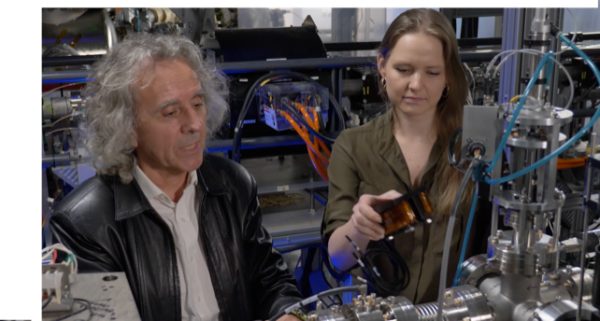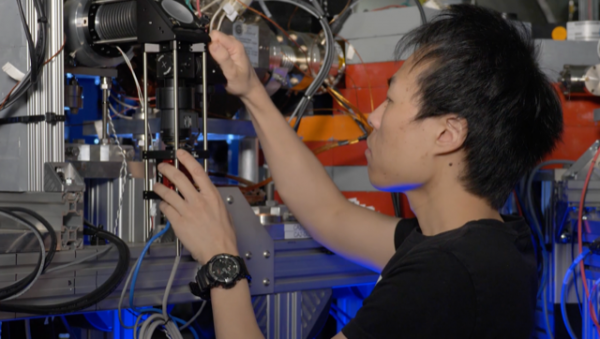Difference between revisions of "CeC"
YichaoJing (Talk | contribs) (Created page with "== '''Coherent Electron Cooling: A Futuristic Technology '''== center '''Introduction''' Physicists and engineers who create p...") |
YichaoJing (Talk | contribs) (→Coherent Electron Cooling: A Futuristic Technology) |
||
| Line 6: | Line 6: | ||
Physicists and engineers who create particle accelerators are often working on such new, cutting edge ideas that they have yet to be implemented in practice. One such idea is Coherent electron Cooling (CeC) which would help to provide powerful beams of colliding particles in significantly less time than other techniques. It uses the coherent responses of the electrons in an electron beam to reduce or maintain the emittances of a circulating particle beam in a storage ring. The CeC technique has not been yet demonstrated experimentally but efforts are underway to do just that. | Physicists and engineers who create particle accelerators are often working on such new, cutting edge ideas that they have yet to be implemented in practice. One such idea is Coherent electron Cooling (CeC) which would help to provide powerful beams of colliding particles in significantly less time than other techniques. It uses the coherent responses of the electrons in an electron beam to reduce or maintain the emittances of a circulating particle beam in a storage ring. The CeC technique has not been yet demonstrated experimentally but efforts are underway to do just that. | ||
| + | |||
| + | [[Image:cec3.png|600px|Image: 1200 pixels|center]] | ||
'''Emittance and Luminosity''' | '''Emittance and Luminosity''' | ||
Revision as of 14:44, 14 June 2023
Coherent Electron Cooling: A Futuristic Technology
Introduction
Physicists and engineers who create particle accelerators are often working on such new, cutting edge ideas that they have yet to be implemented in practice. One such idea is Coherent electron Cooling (CeC) which would help to provide powerful beams of colliding particles in significantly less time than other techniques. It uses the coherent responses of the electrons in an electron beam to reduce or maintain the emittances of a circulating particle beam in a storage ring. The CeC technique has not been yet demonstrated experimentally but efforts are underway to do just that.
Emittance and Luminosity
What is emittance? Accelerator beams that are circulating in particle accelerators or colliders are usually characterized by their size and energy spread. To generalize these properties and make them applicable for any accelerator system, collider physicists and engineers use a definition of “beam emittance” which represents standardized measures of the beam size, particle density and velocity spread. To improve the performance of an accelerator one aims to reduce the beam emittance, and the methods and techniques used for reduction of the beam emittance are called “cooling” techniques. The term “cooling” has been introduced here in analogy with the kinetic theory of gases, where the beam of particles with a large emittance is likened to hot gas particles bouncing in an enclosed container. Hence, if we would like to reduce the emittance of a beam, we would essentially want to reduce the velocity spread of the particles, which is analogous to reducing the gas temperature. That’s how the term “cooling” appeared in this application to particle accelerators.
While there are a variety of available cooling techniques, the time it takes to cool a high-energy high-intensity beam might be on the order of several days. Coherent electron Cooling is one of the most advanced cooling techniques that allows a sufficient reduction of the beam emittance within several minutes or hours, depending on the beam parameters.
This brings up the concept of “luminosity”. Luminosity is one of the main characteristics used for evaluation of the collider performance. It tells us how many interactions between subatomic particles took place within a certain period of time in the region where beams collide. One of the main goals of people working with collider technology is to increase the luminosity of modern colliders.
The ultimate luminosity goal of the EIC (the new electron ion collider to be built at Brookhaven National Laboratory) requires the protons to be compacted into a small phase-space volume, i.e. to a small size and small velocity spread in all directions. The scattering inside the volume is heating protons, which in the accelerator physics lingo is called “emittance growth”. Without an effective beam cooling, the size of the proton beam will keep growing and the EIC will not be able to reach its luminosity goal. CeC could serve as a cooling mechanism in the EIC to reach its luminosity goal.
History of CeC
The idea of CeC was first proposed by Ya. Derbenev, currently at the Thomas Jefferson National Accelerator Facility, in the early 1980s. A CeC scheme with a free electron laser (FEL) amplifier has been proposed by Prof. V. Litvinenko of Stony Brook University in 2008. In 2013, D. Ratner of the Stanford Linear Accelerator National Laboratory proposed a CeC scheme which is based on the microbunching instability developed as the electrons passing through bunchers. In 2018, Prof. Litvinenko and his team extended a version of a CeC system to include one based on using a microbunching plasma-cascade amplifier.
Work on a CeC demonstration has been going on since 2014. Interesting problems have appeared and been resolved in turn.
Since 2014 the CeC team has commissioned a sophisticated superconducting radiofrequency (SRF) linac, including the unique record-performing SRF electron photoinjector, and has demonstrated the key performance parameters of the electron beam necessary for the success of the CeC proof of concept experiment. The interaction between the CeC electron beam and RHIC beam has been established. As the next steps, the CeC team is aiming to establish reliable high gain plasma-cascade amplifier operation and proceed with the CeC demonstration experiment.
Alternative Technologies
Are there alternative technologies? Traditional electron cooling and optical stochastic cooling are two possible alternative beam cooling techniques. The advantages of the traditional electron cooling and optical stochastic cooling is that they are both have been demonstrated experimentally. The disadvantage of the traditional electron cooling is that its cooling power decreases rapidly with the energy of the particles. The disadvantage of the optical stochastic cooling is that it typically works only for a specific energy of the particles and since the EIC is planned to work on multiple energies, its applicability is limited.
While CeC hasn’t been experimentally demonstrated, it has a tremendous potential since it has significant advantages over the existing methods.
The Project: Youth, Excitement and Novelty
Yes, young scientists and engineers are involved in the CeC experiment. The CeC team consists of scientists and engineers at various stages of their careers. Five graduate students obtained their PhDs while working on the experiments and young engineers are working for the experiment in the areas of lasers, instrumentation, diagnostics and controls.
What is exciting about this project is that the CeC experiment requires a high quality electron beam with state-of-the-art stability. While it is frustrating when the experiment does not achieve what was expected in the past runs, it is exciting when the problems were finally identified and successfully solved. Even though the final goal of the CeC experiment has not been achieved yet, the first observations of the ion imprinting and the plasma-cascade amplification are remarkable first-ever achievements.
Unlike some of the on-going work on improving accelerator technology, the CeC is a novel technique in the sense that there is no obvious optimal path leading forward. For example, there are various schemes for amplifying the signal imprinted from the ion beam but it is unclear which one is the best to be used for the EIC. Although work on CeC has been encountering some surprises, in working towards solving these new issues, progress does continue toward new and exciting developments in accelerator technology.

